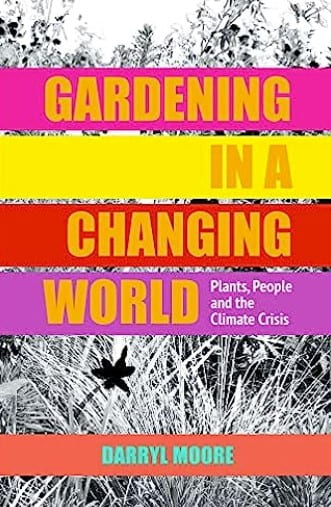Gardening in a Changing World by Darryl Moore part 1 of 6
Plants, people and the climate crisis.

In an increasingly post-industrial, urbanized world, gardens and parks offer opportunities for engagement that are beneficial for physical and mental health. This has become acutely apparent during Covid-19 lockdowns. Perhaps it shouldn’t be surprising, as these places with plants, evolutionary ancestors that have successfully lived on the planet for 420 million years. They know a thing or two about adapting and surviving through troubled times.
So, perhaps we can learn from them, if we can first get to understand them better and move beyond many current attitudes towards them.
Preface p7
I would love to do that but unfortunately this book has all the appeal of a rather dry, academic tome: lots of small dense text on the page and very few pictures for a gardening book. The title really appeals to me as it is something I am very interested in, having had the hottest, and possibly dryest, June on record. I have tried twice to read it and failed miserably. I can’t get a sense of it and it is so very dry. However, I do really want to read it so have decided to read it in sections – there are 6 and I will read one a week. The first section is Plants as Producers.
We are inextricably linked to plants – they provide oxygen and food, materials to build with, medicines to heal us and can be made into cloth to clothe us – yet we seem to feel that they are not important. A new development trumps an old tree, a neat, tidy garden is more important than a bunch of nettles in an unused area andthey are often overlooked in terms of helping us to solve the problems we face. Geoff Lawton, he of permaculture fame, says that we should ‘farm like a gardener and garden like a farmer’ if we are to survive these times.
We know that plants have evolved over time to suit almost every condition found on earth through their physical processes and over long stretches of time when the world has been hotter, drier, colder, wetter and with CO2 concentrations that have been higher and lower. How quickly they adapt has been the key to their survival. What is different now is the rate at which these environmental changes are occurring and in many instances the complexity of the changes adding to the challenges.
Many plants find themselves living at the very edges of their ecological range, as do many insects and other animals. Isabella Tree writes very clearly about the rewilding at Knepp that they are discovering that some bird behaviour is very different to that reported on and written about over the last 40 years. Tree refers to this as ‘species-shifting syndrome’ as exemplified by nightingales and purple emperor butterflies. Nightingales are often referred to as a woodland species but left to their own devices at Knepp, the nightingales have nested in wide, prickly hedges and open-grown scrub both of which are rich in insects, not woodland. Could it be that they are seen in coppiced woodland because they are clinging on to a habitat that is present, not their preferred but the least worst thing. Time and again, Tree says that if you look in wildlife guides over a 100 years ago the range and type of habitat described in them is different to the modern guides. If we take the modern guides at face value we would be planting lots of coppiced woodlands to encourage nightingales but it wouldn’t. They cling on to these as a last hope not actively choosing them as their preferred habitat. She demonstrates the same shifting syndrome with butterflies and suspects the same thing with collared doves. It must be happening with plants.
At its simplest, the more diverse an ecosystem the more stability it has. It is quicker to recover from a disturbance and it means that whilst some species may not survive, others will do quite well ensuring the overall functionality of the system. Changes in plant fowering time affect the interactions between pollinators and herbivores. Alterations to the concentrations of chemicals in plants such as nitrogen will affect protein supplies for herbivores and the amount of plant matter they consume. More frequent and intense drought periods, resulting in a reduction of plant species, disrupts the entire community over time, decreasing diversity and making its functioning less efficient. And this downward spiral continues.
To link this to my garden and the wildlife area on the allotments, the early flowering of plants due to the drought will mean that the pollen, nectar and seed heads are not present when the insects and birds need them leading to a reduction in their numbers. Is this what is happening now to butterflies? I have seen far fewer this year than previous years.
I wonder if one of the things I am finding difficult about the book is the disconnect between the idea in the introduction of knowing the above and what we need to do to change the situation. Just knowing isn’t enough – we need help to make changes. What should those changes be in the context of a garden? Maybe this will come later. Patience!
You can read part 1, part 2, part 3, part 4, part 5 and part 6 if you click on the links.